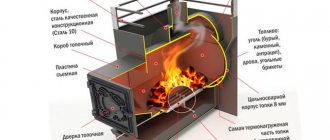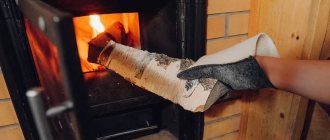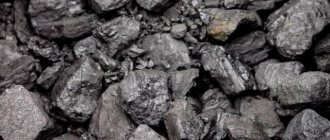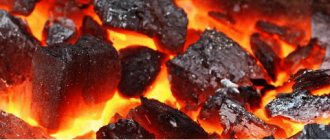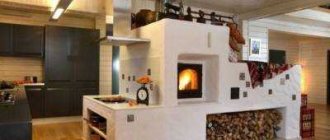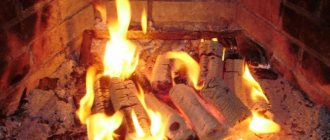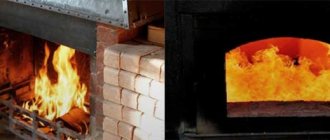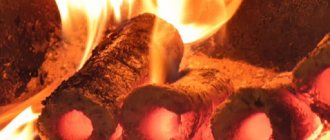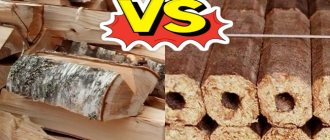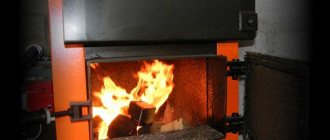Owners of private, non-gasified houses often think about how best to heat the stove. In most cases, it all depends on what type of fuel the heating system is designed for. First of all, you need to know that in order for the efficiency not to decrease, and the equipment itself to work longer than the declared operational life, you should use only high-quality materials, and it does not matter what you heat with: coal or wood.
Throwing fuel into the firebox
What stoves can be heated with coal?
Potbelly stoves are most suitable for using coal. You can store both firewood and coal in them. After all, the material from which they are made is heat-resistant; it can withstand high temperatures for a long time.
Coal is an excellent option for a potbelly stove
Experts do not recommend using coal to heat a Russian stove. After all, its design was originally developed for wood fuel. This is due to the fact that the combustion temperature of coal in a furnace is much higher than that of firewood or other types.
A Dutch oven is also not suitable. After using fuel in such a stove, its condition deteriorates significantly: deformation of the body and parts from high temperatures, accumulation of soot in the chimney.
Heating a brick stove with coal is possible in two cases : if its firebox is lined with fireclay bricks, or if it consists of a steel frame with a wall thickness of at least half a centimeter.
Fireclay brick is resistant to high thermometer values; it can easily withstand the main temperature, while masonry made from ordinary bricks will be affected by less strong indicators. And thick steel will not deform and will easily withstand burning.
The grate in brick kilns fired with this type of fuel should be located two rows lower than usual. Coal fuel also requires an additional exhaust system.
If you equip an ordinary wood-burning brick stove correctly, then you can easily use coal to heat it.
Owners' opinions
Below are some reviews from stove consumers.
“We purchased a stove for the Rus bathhouse with a fireplace door. It looks great and very presentable. And it works even better - a couple of clutches, and the steam room is already 110°C. Comfortable warmth without the feeling of suffocation. Economical fuel consumption coupled with a stylish design and an affordable price - Teplodar with both hands!”
Zarina Radina, Sverdlovsk region.
“The most affordable option for our home was the opportunity to buy a Teplodar gas stove. We doubted for a long time whether this would be an effective solution. But in reality everything turned out to be very simple and functional. The latest design of the stove allows you to steam comfortably after just 30 minutes of intense heating. No worse than wood heating. Thanks to the manufacturer, we were satisfied."
Sergey, Moscow.
“Based on feedback from friends, I decided to purchase a Rus stove from the manufacturer Teplodar. Outwardly, it is presentable; I was attracted by the increased manufacturer’s warranty of up to five years. Well constructed - thick, good steel. It’s a pity I didn’t immediately buy a tank for heating water; then I had to run around looking for a suitable one. I haven’t found any complaints in operation yet.”
Mikhail Badin, St. Petersburg.
“Our bathhouse is small, we only have enough money for it, so an electric stove is enough for us. We purchased a very inexpensive and practical option from the Teplodar company. We steam with pleasure, just like in a real Russian bathhouse. Installation is simple and consumes little electricity. Considering that we use the bathhouse once a week, the operating costs are quite reasonable. Overall, the result exceeded all expectations.”
Peter, Ekaterinburg.
Price
You can buy sauna stoves in many dealer stores, as well as on the website of the manufacturer Teplodar. The table shows the price of equipment without taking into account the cost of additional installation of a gas burner.
| Name | Dimensions (WxHxD), mm | Steam room volume, m3 | Price, rubles |
| Blast furnace 25 LC | 615x995x705 | 10-25 | 26000 |
| Cascade 18 LP Panorama | 380x920x770 | 10-18 | 20500 |
| Kuban 20 L | 500x865x700 | 10-20 | 19900 |
| Laguna 12 TK | 855x330x690 | 6-12 | 15000 |
| Teplodar Rus 18 LNZP Profi | 335x810x790 | 10-18 | 22600 |
| Rus Panorama 27 LNZP | 440x930x800 | 18-27 | 30800 |
| New Rus' 18 L (2004) | 395x815x805 | 10-18 | 13800 |
| Sahara 16 LRK | 785x380x755 | 8-16 | 17500 |
| Siberian cliff 20 health care facility | 835x565x730 | 10-20 | 26500 |
| Siberia 20 LRK Panorama | 785x375x750 | 10-20 | 23200 |
| Taiginka 10 TU | 405x330x705 | 4-10 | 8500 |
| Electric heater SteamFit 3 | 560x400x240 | 12 | 16700 |
| SteamGross 3 oven | 580x530x643 | 26 | 41000 |
What kind of coal is suitable?
There are different types of fuel. Let's look at them in more detail:
- Lignite. The youngest species, characterized by high friability. It has a fibrous structure. A common fuel in power plants and factories. It is used infrequently for heating homes, as it does not heat a conventional stove properly.
- Brown. This fuel consists of peat and carbon. It has a low combustion temperature due to the large amount of water and other impurities. Can be used as local fuel.
- Coal . It has a high combustion temperature due to the large amount of carbon in the composition. Has a high heat of combustion.
- Anthracite. Contains up to 95 percent carbon. It has the highest degree of combustion heat. One disadvantage is poor ignition.
For heating stoves in households, coal and anthracite are usually used, as they have greater heat transfer. This type of coal for heating a home will be required several times less than brown coal or firewood. The only drawback is poor ignition.
This problem can be solved with the help of firewood: first put logs in the firebox, and after they burn out, add anthracite.
Long-flame coal has the best price-quality ratio. It ignites quickly, has high heat transfer, and is unpretentious in storage and use.
Operating principle of a long-burning boiler
Boiler design diagram.
Automatic regulation consists of the control unit and the operation of the fan, which is responsible for the temperature of the coolant. The increase in coolant temperature depends on the access and volume of incoming oxygen, and the temperature in the system is controlled by a temperature sensor located in the water jacket of the boiler. When the set coolant temperature is reached, the oxygen supply is turned off and the fan stops operating. When the temperature drops below the set point, the automation transmits a signal to the fan, and it turns on and begins to pump oxygen into the boiler chamber, the smoldering coal again begins to flare up actively.
You can also heat the boiler in automatic mode: the boiler is in standby mode, that is, at certain intervals the fan turns on and allows the coal to die out: it maintains it in an undying state.
Preparing the stove for lighting
Firing a stove with coal requires preliminary preparation of the heating device itself.
Before the start of the heating season, take a number of actions:
- Inspect the oven carefully. If defects are identified in the housing, repairs must be made: seal the cracks with mortar, replace parts, if necessary.
- Clean the chimney of soot. Large accumulations of combustion waste can cause improper air circulation or even fire in the structure.
- Check all doors, dampers, and latches.
If you have verified that there are no defects and that the heating structure is in good condition, you can proceed to the next step.
Causes of smoke
Sometimes, even when the stove is properly lit, smoke may form. The reason may be poor quality coal. But most often the following factors influence smoke:
- the appearance of cracks in brickwork,
- presence of blockages in the chimney and stove channels,
- destruction of the internal part of the heating device.
The appearance of smoke may be due to blockages in the chimney and stove channels
When igniting a very cool firebox and the entire stove system, smoke may also be released. Soot often forms when two stoves are directly connected to one chimney. To avoid smoke, a smoke damper is installed.
Coal laying
How to heat a stove with coal correctly? Correct use of this type of fuel requires its special storage. Stones are poured into the firebox only after it is fully heated with the help of firewood.
First, paper, thin wood chips, sawdust or other flammable material are placed on the grate. The logs are not stacked very tightly on top, creating air gaps for better combustion.
Coal laying
Periodic boiler cleaning
After learning how to fire a coal boiler, you need to learn how to clean it. These actions will help prolong the performance and neat appearance of the unit. During the smoldering process of coal at high temperatures, the device leaves a minimal amount of waste, which is dumped into the ash pit. The amount of waste is practically invisible; it becomes visible only after prolonged use of the device.
The entire combustion process takes place on a grate. But over time, the time comes when the solid fuel boiler needs to be cleaned. Such cleanup activities are not considered particularly time- or financially expensive.
These products are thrown directly onto hot coals, resulting in the formation of acrid smoke, which will remove all the toxins inside the boiler and chimney. In this case, the operation of the device can not be interrupted. In addition, the walls of the device can be cleaned with a brush and a wire brush, which are usually included when purchasing the equipment.
Ignition
After burning a batch of logs and pouring coal into the firebox, you need to monitor its ignition. If a small amount of coal fuel has already burned out, you can safely add the next one.
Adding additional coal
You just need to make sure that there are air gaps between the stones. They can be made with a poker. By opening and closing the blower we regulate the combustion process.
Heating recommendations
Even a heating device designed exclusively for coal is fired using paper and a layer of wood. Coal is added only when the temperature in the firebox reaches a level sufficient for burning the rock. The first layer of coal material should be at least 6 cm. If the optimal size of the layer has not yet been determined by the owner of the stove, it is worth starting with this volume and increasing it to 15 cm if necessary, when the fuel burns well.
For heating boilers adapted for coal, the ideal shaft design includes vertical walls and a grate. The firebox is located at a sufficient height to ensure safe operation and the combustion process is not disturbed. During kindling, the coal is placed on the grate, with the valve slightly opened until the rock begins to burn well (then you can open it to maximum).
Dry fuel is best suited for kindling. Filling the stove with wet material is acceptable, but then the amount of soot on the walls will increase, and cleaning the grate and walls will be required earlier. The fuel, which is supplied after the first portion, is added only when the material poured in earlier has ignited efficiently.
Before supplying coal, always close the ashpit - this is a safety requirement first and foremost.
Features of kindling in winter
How to properly heat a coal stove in winter? In winter, cold air creates a special draft. It prevents smoke from escaping into the street.
- To ignite the stove in severe frost, you can use improvised means.
- If you have a hair dryer, take it.
- Close the ash pan door, open the firebox and valve.
- Preheat the oven for a few minutes and proceed with normal operations.
- After heating, smoke will not go into the room, and the fuel will ignite.
What not to do?
When burning coal in a stove, the following is prohibited:
- use pieces of bitumen, plastic, construction and household waste as kindling material;
- leave the vent and combustion door open at the same time;
- When lighting, use gasoline, kerosene, alcohol, and other flammable substances.
It should be remembered that adults should constantly monitor the combustion process and under no circumstances transfer this function to children.
To ensure maximum heat transfer, it is necessary that the coal be in the form of not too large pieces. It is not recommended to use excessively wet fuel, since during combustion a lot of steam will be released from its surface, which will significantly reduce the efficiency of the combustion process.
Firebox rules and coal combustion temperature in the furnace
Basic Rules:
- Coal is added as it burns. Its thickness should not exceed 60 mm.
- When opening the firebox door, the vent should be closed.
- If the stove is equipped with a hob, the vent should be covered at any load. If this is not done, smoke will enter the room.
- The fuel should burn evenly.
- If you have a large amount of coal dust left over during coal storage, you can use it. How to properly heat a stove with coal dust? Wait until the bulk of the fuel burns, and then add a small amount of dust.
- When the combustion ends, you need to cover the vent.
- The chimney closes only when the coals have completely burned out.
It is not recommended to immediately heat the oven too much. It is better to do this gradually, so that a comfortable temperature will be maintained in the room for a long time. You should pay attention to the moisture content of the coal.
If the fuel has an excess of moisture, then less heat will be released during the heating process. This is due to the fact that drying requires significant energy expenditure.
The combustion temperature of coal in a conventional furnace can reach thousands of degrees. But usually it is much less - 600-800 degrees. The combustion temperature of anthracite at home is 500-600C, and the highest reaches 2100C.
Dangerous gases
When operating a coal heating boiler in certain weather conditions (strong gusty winds) and when the chimney or the boiler itself is clogged, toxic gases may be released into the room. If the boiler is installed in a room connected to residential premises, or people may be in the room with the boiler for a long time, you need to be very careful. The fact is that the flammable gases released during coal coking have a strong, unpleasant odor. Their entry into the premises cannot go unnoticed. People present immediately begin to react, ventilate the premises, clean the boiler, etc.
It’s another matter when the first stage of coal combustion is completed, and only coke remains in the boiler, which burns out there. At this moment, CO - carbon monoxide or, which is the same thing, carbon monoxide may enter the room. And this gas has neither color nor odor. Its inhalation leads to hypoxia, mild euphoria, and drowsiness. Those who fall asleep in a room with large amounts of carbon monoxide (CO) sleep sweetly and usually do not wake up. Therefore, it is necessary to install a carbon monoxide detector in the room with the boiler. Problems with carbon monoxide are specific to coal, since conditions under which CO is released without any accompanying odorous gases are found only with coal heating.
| Here is a selection of materials: IN Everything you need to know about heating and climate control Features of the selection and maintenance of boilers and burners. Comparison of fuels (gas, diesel, oil, coal, wood, electricity). Do-it-yourself ovens. Coolant, radiators, pipes, heated floors, circulation pumps. Chimney cleaning. Conditioning |
My boiler tried to poison me with carbon monoxide several times. This happens when the wind does not just blow in any direction, but twists and blows from top to bottom into the pipe. The concentration of carbon monoxide in the room with the boiler was not high, but the sensor was triggered and warned me of the danger.
Conclusion
Coal is the most common type of fuel. Its heat transfer is significantly higher than that of firewood, briquettes and pellets. Not all types of stoves can be heated with this product. To use it, you need a special firebox made of fireclay bricks or dense steel.
The process of laying, igniting and burning a corner will not require much effort if you follow the basic rules. But it will not be possible to heat the room with this type of fuel alone, since additional materials are required for ignition: paper, wood chips, small logs.
Alternative fuels
Today, the most popular type of fuel used for heating residential and industrial facilities is coal. If desired, it can be replaced with alternative raw materials:
Peat
One of the most efficient types of fuel raw materials. Peat is suitable for stoves with special fuel chambers that increase draft during its combustion.
The material is produced in pieces and pressed briquettes. Peat moisture levels range from 22 to 40%, which leads to the formation of large amounts of ash. In terms of its calorific characteristics, it is significantly inferior to firewood, which is the main disadvantage.
Pellets
Fuel pellets are produced from dry biomass (sawdust, wood chips, bark and wood dust) by hot pressing. These are small capsules whose humidity level does not exceed 10%, so they are an excellent fuel for a brick or metal stove.
Unlike firewood, pellets can burn for quite a long time, releasing carbon dioxide and water. They are distinguished by environmental friendliness, safety and high calorific value.
The most important stage
Everything is ready to start lighting the fireplace. This process is considered a highlight, as it requires a certain skill and endurance. Many hobbyists are skeptical about modern means of automatic ignition, considering it unnatural. However, not everyone is able to light firewood with one match. Therefore, you should follow all the recommendations, which begin with the methods of stacking firewood:
- If the fireplace is not being lit for the first time, then you should not remove all the ash remaining from the previous use from the grate. A small layer of it serves as excellent thermal insulation protection. It will protect the fireplace body from overheating and prevent cold air from entering the firebox through the ash pan.
- Any kindling of a fireplace begins with the stacking of firewood. The classic method involves placing thicker ones on small branches or splinters. Gradually, the wood pyramid is formed by logs of larger diameter. The most important thing is to leave enough space between layers to allow air flow.
Preparing to light the fire
- An alternative method is reverse laying. It consists in placing thick logs on the bottom. Thinner firewood is placed perpendicular to them. By alternating the direction of placement and reducing the diameter of the firewood, we come to the conclusion that there will be small kindling on top. As a result, the fire will move from top to bottom. This method gives the effect of a closed firebox, that is, longer burning of wood, and therefore greater heat release.
- Before lighting the fireplace, you need to check the draft again. If the room is cool enough, there may be no draft due to cold and damp air in the chimney. To prevent the fireplace from smoking when you light it, you need to open the direct valve in the pipe and warm the air using an old newspaper. Once the draft appears, you can begin to light the fireplace. Make sure the ash pan or ash door is open.
- It is convenient to light firewood with paper. Roll it up and light it with a match. Then take it to the wood well and slip it between it and a layer of old ash. When the wood begins to burn on its own, you will have to close the glass screen, if any, so that sparks do not fly beyond the space limited by the firebox.
Beautiful flame in the firebox
How to remove ash?
Heating solid fuel boilers
When the stove is heated with wood, removing the ash is very simple. The fuel burns out and falls into the ash pan chamber.
Coal has a much longer burn time, so it is quite difficult to remove slags in time. Laying with wood saves the situation - a layer of firewood, a layer of coal. You can cope with this problem by increasing the combustion temperature. Therefore, it is useful to learn how to regulate cravings.
Popular models
The most famous suppliers of solid fuel units are the following brands:
- Lithuanian Stopuva;
- German Buderus;
- Czech Wattek;
- Belgian ACV;
- Austrian Wirbel;
- Russian NMK, Zota and TeploGarant LLC.
Among the models on the market from various companies, there are several popular devices.
Stropuva Mini S8
A power-independent unit serving an area of up to 80 square meters. m. Works with three types of fuel and is distinguished by its small size. Equipped with a convenient vertical firebox door.
The special design of the ash pan allows you to reduce the need to clean it to twice a month. One bookmark is enough for daily heating; the pellets burn out in 48 hours.
Advantages:
- high efficiency;
- quality of construction;
- safety;
- presence of a thermometer.
Flaws:
- heavy weight;
- The rough surface of the door makes it difficult to clean.
| Roman Oborin: | Igor Falaev: |
| “Economical and compact unit, burns for a long time. It consumes little fuel, heats the house well, and does not produce soot. The only negative is that it’s a bit heavy.” | “A small, convenient barrel, the device is immediately ready for use, you don’t need to assemble or screw anything in. The door handles are of high quality and reliable, they do not open spontaneously. It takes a long time to heat, it can burn for up to 20 hours.” |
Teplodar Cooper Expert-15
Russian model with the ability to install a burner.
In the upper half of the housing there is a fitting for air outlet. Compatible with firewood, coal and briquettes. Three air entry zones and top combustion ensure long-term heat maintenance. At the bottom there is a water reservoir that prevents excessive heating of the floor. A steel plate protects the door from heat. You can additionally attach a draft regulator.
Advantages:
- possibility of installing a pellet or gas burner;
- convenient door placed at an angle;
- continuous burning for 24 hours.
Flaws:
- complexity of installation;
- small firebox.
| Oleg Egorin: | Semyon Ivin: |
| “It’s a convenient boiler, you can buy an additional burner, it works for a long time and even after switching off the house remains warm.” | “It’s not a bad unit, it’s enough for almost a day of heating, but it consumes a lot of fuel. Convenient door design for stowage." |
ZOTA Topol-16VK
A device with a water circuit at an affordable price. The triangular shape of the pipe avoids blockages and increases the service life of the device. To refuel the boiler, you can use firewood, coal and pellets.
The model is distinguished by a spacious firebox and the possibility of top and side fuel storage.
Advantages:
- low price;
- ease of use and cleaning;
- efficiency.
Flaws:
low efficiency.
| Vladimir Kharitonov: | Alexey Zaitsev: |
| “A high-quality device at an affordable price for its segment. Works flawlessly." | “The device is pleasant to use, cleans without problems, you can load different types of fuel, both briquette and regular.” |
Teplodar Cooper Expert-22
The device is small in size, capable of operating in 4 modes: fast heating, classic, medium and maximum. Combustion from top to bottom ensures uniform and longer combustion of the material and good heat transfer.
The upper cleaning hatch is protected by a steel screen that prevents burning.
Advantages:
- two hatches for cleaning;
- inclined door for top loading;
- top burning function.
| Evgeny Zherdev: | Ivan Alaev: |
| “Sophisticated heating adjustment, you can adjust the burning duration from 30 minutes to a day. Easy to clean, special cleaning accessories included.” | “A high-quality model, the design allows you to connect heating pipes from either side. The device comes with a heating element and a thermomanometer.” |
Stropuva S30
Solid fuel boiler for placement in commercial and residential premises. Equally effective for year-round and seasonal use. It is characterized by high efficiency, is independent of power supply and is compatible with a variety of fuel materials.
The device has compact dimensions and is environmentally friendly. The duration of firewood burning is up to 30 hours, briquettes can smolder for up to 2 days.
Advantages:
- safety of use;
- high efficiency;
- durability;
- build quality.
Flaws:
high price.
Algorithm of actions
In fact, everything is extremely simple:
- Initially, the furnace firebox is covered with a small amount of paper.
- It is necessary to put wood chips, small wood shavings or bark on top of it; it must be dry.
- For the next layer, take logs, but their thickness should be less than those that are already used in a burning oven. This amount of materials will be enough to warm up the heater.
- When the flame is sufficient, the firebox is filled with firewood, and its level should be 20 cm lower than the firebox. With this approach, the fuel will have time to burn out even before it enters the chimney.
- When the required amount of warm air has accumulated, you can begin to add coal, starting with small pieces and throwing in more and more.
Packing in bags is the most convenient
A set of measures before starting the fire
For the normal passage of the entire combustion process, it is necessary:
- carefully inspect the stove structure, starting from the firebox door of the stove and ending with the chimney. If cracks are found in the brickwork or chimney pipe, they must be sealed with a sand-clay mixture. Otherwise, the room will instantly fill with smoke, a large amount of carbon monoxide may appear, and small cracks will turn into large cracks and can actually damage the masonry;
- whitewash the pipe if you have not used the stove for a year or more;
- clean the chimney structure, including chimney channels, pipes from soot (if you have not used the stove for 3-4 months);
- clean slag and ash from the furnace. To avoid the appearance of dust in the room, combustion waste must first be filled with water, then raked out and taken outside;
- check for traction. To do this, insert a newspaper folded lengthwise into the firebox, set it on fire, and if smoke goes up the chimney, then everything is fine;
- use a dry cloth to wipe the outer part of the heating structure, otherwise an unpleasant odor will appear during the fire;
- Heat a little at a time 2-3 times a day, if the unit has not been heated for a long time, to prevent overheating of the stove.
